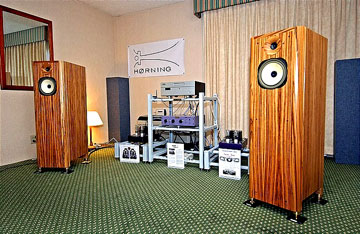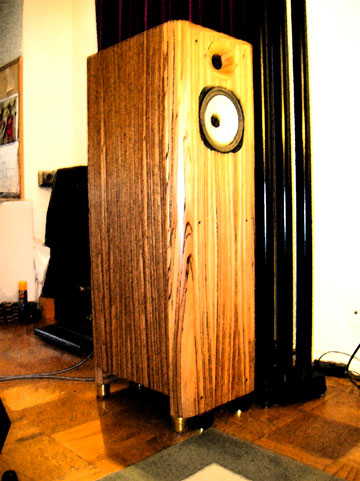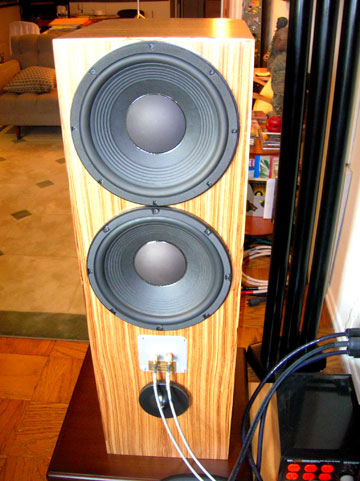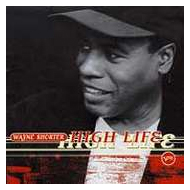You are reading the older HTML site
Positive Feedback
ISSUE
20
july/august
hørning
The Hybrid Agathon Ultimate - Portrait of a Loudspeaker
as reviewed by Marshall Nack

|
MARSHALL NACK'S SYSTEM
LOUDSPEAKERS
ELECTRONICS
SOURCES
CABLES
ACCESSORIES
|
The Hørning Hybrid Agathon Ultimate loudspeakers (wow, that's a mouthful) have a different kind of sound than any speaker I'm acquainted with. It's not the sound of dynamic drivers (such as the Eggleston Works or the Kharmas I'm familiar with), or panels (I spent a good dozen years working through the Magnepan line), or horns (what I've heard of Avantgarde horns and the like in showrooms). Maybe it's that Lowther driver, with its unprecedented midrange vitality—there's just so much life in the midband—but Lowthers in showrooms have never turned my head.
Immerse yourself in the acoustic
I began with the Reimyo amplification (the eight-watt PAT-777 amp and the CAT-777 pre-amp), which I knew capable of throwing a large-scale blueprint populated with beautiful, if oversized, images from my experience with them and the Kharma CRM 3.2 speakers. That was a memorable combo. Now the Reimyo gear was matched up with the high-sensitivity, full-range Agathons. What resulted was about the last thing I expected and confounded all my expectations. The low-wattage SET amp mated to the 100dB sensitivity speakers threw a really dense stage, about as big as it gets in my room. The inhabitants of that stage were weighty, vital, dynamically charged simulacrums prancing about the front end of my room. Impressive enough, but the clincher was the way the Hørnings were able to set the air in motion. That, plus the sense of power conveyed by their low end. The Agathons do that rare thing of energizing the room similar to the way real instruments pressurize the air. Now, I'm not talking about reproducing a solo voice or a duet—most any old SET rig can get that right. This was the Lincoln Center Jazz Orchestra doing Big Train (SRCS 8980, Japanese import). A jazz orchestra energizes a heck of a lot of air. Part of this stunning performance is from a low end that you can feel in your chest. Part comes from the purity of the SET amplification mated to a high-sensitivity speaker. And a good bit is the Agathons enveloping "fill" sound.
The Agathon excites the room from three directions: directly forward (the front-mounted drivers); floor-borne (from the internal horn), and from the rear (the port and the rear wave of the bass drivers). The latter two produce lots of fill—you won't find dark spots between the instruments—and this is where the acoustic fullness comes from. You hear the sound, but you also feel it all around you. It doesn't stay put in front by the speakers, but kind of envelopes the listener. All this from just eight watts!
Design and Technology

Agathon front [fresco by Robinson]
The Agathon is a complex design with many parts. In the simplest terms, it is a three-way, floor-stander with individual loading for each driver. The two 12" woofers on the rear side fire into the cabinet, into a chamber of sizable length. Their output traverses this chamber until it terminates at the juncture with a hyperbolic-shaped interior horn. The midrange and part of the treble frequencies are handled by an eight-inch, wide-band Lowther. This driver's rear wave is loaded into another interior chamber, which eventually feeds the common horn. Finally, the rear wave from the Lotus tweeter (Tommy Hørning's own design and manufacture) loads the same chamber used by the Lowther. In this way, all frequencies eventually commingle in the horn, whose mouth opens at the bottom of the speaker. The Agathon is a three-way that loads into two interior chambers and then into a single interior horn. I told you it was complicated.

Agathon rear
Now how do all these parts come together time-wise? Given the complicated design, it could so easily have fallen prey to phase anomalies, frequency bumps and suckouts or timing issues, but come together they do.
Here's how: It has to do with the variable lengths of the two loading chambers. The tweeter/midrange chamber enters the horn at a point near the horn's beginning, at the top end of the speaker: these frequencies have to travel almost the entire length of the horn before releasing at the speaker's base. The bass chamber enters the horn near the middle, and only has a little ways to go before reaching the horn's mouth. Voila—time alignment. By the way, the cabinet interior is mostly an empty space—the horn takes up almost the entire volume. Directing the sound through the two chambers and then the horn multiplies the cubic volume of pressurized air—that's how this medium sized floor-stander makes the kind of sound you would expect from bigger cabinets. And last but not least, the horn has an adjustable rear port (called a Hørning Acoustic Variator). By screwing the Variator open or closed, you can tailor the compression inside the speaker and the proportion of sound coming from the floor vs. the rear.
Simple but Exotic Crossovers
The woofers are custom made to Hørning's spec by Beyma, a pro audio manufacturer. They have huge magnets and are run full-range—they never go into a crossover and naturally roll off at 200Hz. The Lowther (DX4 model in the Ultimate version, the only way it comes if you buy it in the USA. The standard Agathon with DX3 Lowther is available overseas) is not only one of the most expensive, but also one of the fastest drivers on the planet. Its whizzer cap is removed, the paper cone is doped to strengthen it, and a plug is inserted in the center for the purpose of restricting the cone's excursion. That plus a simple crossover limit its top end to 6kHz. The Lowther and the Lotus tweeter share a single hand-built capacitor made of a sheet of copper foil encased in graphite, which is encased again in beeswax-coated paper. These two drivers also share four hand-made resistors, each made out of a single bar of 100% pure graphite. Lastly, there's one common choke. The tweeter is assembled from raw parts at the Hørning factory. It too has an unexpectedly oversized magnet attached to its polypropylene diaphragm, and its own small wooden horn attached to the faceplate. Kondo copper wiring (KSL-SPc) is used internally throughout.
Frequency Spectrum
The Agathons tonal balance is a discovery... and an acquired taste. Generally speaking, contemporary audiophiles like their mid-band served up thin and the highs and lows kept distinct. This frequency balance certainly promotes clarity, and throws in some extra kick and excitement. I like to relate it to front row vs. mid seat in the concert hall. Up front, you get staggering dynamics, a hot treble and lots of separation. Sounds pop out from all over the stage. A little further back it's more of a blend, more integrated, with the midrange dominant—this is the Agathons perspective. The Agathon turns contemporary voicing on its ear.
When I first heard them in the importer's showroom, it was the micro dynamic agility and sheer vitality of the midrange that left an indelible impression—I'd never heard anything like it before. The Lowther driver responsible for this hardly needs an introduction—its speed, frequency seamlessness and coherency are legendary. The Agathon uses this to its advantage.
I do think the Hørning treble is onto something. It is on the shy side—a wallflower present at the party, not the main attraction. While extended, it is soft, round, sweet and reticent, wholly submerged in the overall fabric of the sound, and that is its beauty. It does what it needs to without you ever noticing it. The key is the unusually high crossover point, 6kHz—when's the last time you saw a number that high? The Agathon treble and midrange speak with one voice because it is one voice—the Lowther. By crossing-over at 6kHz, beyond the range of the fundamental of any common treble instrument, even that of a piccolo, the only thing the Lotus tweeter is left to do is the overtones.
In my travels, I find most systems weak from the lower-mids on down. It seems like almost everyone could use more weight and body. Isn't this why the hottest power cords on Audiogon are the Elrods, the Shunyata Anacondas and the Harmonix Studio Masters? These are the beefiest sounding, so it's no coincidence that they are the most sought after. Well, you're going to be placing a lot of ads on Audiogon.
The low-end is one of the Agathon's major strengths. It will also be the major chore for potential owners. The woofers have a tendency to dominate the sound. Two twelves per side is an awful lot of low-end firepower in a speaker this size. Most sub-woofers for residential use have just one 10" or 12" driver. Tommy Hørning believes that multiple large diaphragms restricted to small excursions are less prone to problems than the opposite: small cones having to make large excursions. He may be right, because once you get the bass in line, the Agathons low end is revealed as uncommonly sensitive and dynamically agile. The slightest signal down here is enough to get them going—they start very easily. (Getting them to stop is another matter and mandates an amplifier with good damping capabilities.) That low end also has uncommon resolution. Furthermore, its integration is complete. Most of the low frequencies come from the downward firing horn, where it commingles with the rear wave output of the Lowther and Lotus tweeter.
 The Saint-Saëns Le Carnaval des Animaux
(Virgin Classics 7243 5 45603) with the Capuçon brothers presents an excellent
assortment of instrumental effects, a great CD for evaluation purposes. Given
the SET gear on board, it's no surprise woodwinds sound great. How about high
violin notes that are actually a passing facsimile of the real thing? There's an
unprecedented weight and support, not to mention that acoustic fullness,
underpinning everything from the double bass to the piccolo. Track five, the
well-known duet between the double bass and the two pianos, doesn't shrift the
pianos their shimmering trails, but the bass has a physical presence to it, true
low frequency energy. You don't need to play it loud to feel the air in the room
in motion. It's great to have this abundant musical bass—there's life down
there that is rarely plumbed. When you think about it, the Hørnings were
probably using one, maybe two watts most of the time, and activating the air in
my room more fully than powered subs with 350 watts of dedicated power!
The Saint-Saëns Le Carnaval des Animaux
(Virgin Classics 7243 5 45603) with the Capuçon brothers presents an excellent
assortment of instrumental effects, a great CD for evaluation purposes. Given
the SET gear on board, it's no surprise woodwinds sound great. How about high
violin notes that are actually a passing facsimile of the real thing? There's an
unprecedented weight and support, not to mention that acoustic fullness,
underpinning everything from the double bass to the piccolo. Track five, the
well-known duet between the double bass and the two pianos, doesn't shrift the
pianos their shimmering trails, but the bass has a physical presence to it, true
low frequency energy. You don't need to play it loud to feel the air in the room
in motion. It's great to have this abundant musical bass—there's life down
there that is rarely plumbed. When you think about it, the Hørnings were
probably using one, maybe two watts most of the time, and activating the air in
my room more fully than powered subs with 350 watts of dedicated power!
Bass instruments have enormous potency. Take a listen to the unusual duet of organ and bass-trombone on track four of Vivaldi: Motets (Virgin Veritas 4570 2), with Fabio Biondi's Europa Galanté. Even as both instruments simultaneously plumb their lowest notes, they maintain separation. Counterpoint among low-range instruments like this always caused congealing: the only way to get separation was by lightening up the tonal palette. No need with the Agathon.
 This kind of performance from eight watts is wholly
unexpected. This kind of performance from any number of watts is uncommon. It
upped the credibility quotient considerably. Who would ever associate the
low-powered SET experience with wide frequency bandwidth and fabulous macro
scaling? ‘Cause it's gospel that you need massive amounts of wattage to get good
dynamic swings that include hefty low frequencies, right? Isn't that why guys
are preoccupied with the wattage spec? Little do they know… The Agathon's macro
dynamics are excellent. I mean, can you imagine eight watts comfortably doing
Wayne Shorter's High Life (Japanese Verve CD POCJ-1287)?
This kind of performance from eight watts is wholly
unexpected. This kind of performance from any number of watts is uncommon. It
upped the credibility quotient considerably. Who would ever associate the
low-powered SET experience with wide frequency bandwidth and fabulous macro
scaling? ‘Cause it's gospel that you need massive amounts of wattage to get good
dynamic swings that include hefty low frequencies, right? Isn't that why guys
are preoccupied with the wattage spec? Little do they know… The Agathon's macro
dynamics are excellent. I mean, can you imagine eight watts comfortably doing
Wayne Shorter's High Life (Japanese Verve CD POCJ-1287)?
True Low Notes
Granted, it wasn't the damping factor and tautness on drum whacks that you'd get with a 600 watt Krell amp driving Wilson X-1 Grand SLAMMs. Members of the audio clique were prone to fault the bass along the lines of lack of definition, warmth and ripeness. Non-audiophile visitors, on the other hand, often commented on the naturalness of the low-end. What gives? They're both right. A double bass section in Carnegie Hall's acoustic sounds tight, somewhat dry, with lots of definition—along the lines of audiophile taste. On the other hand, an unamplified double bass in a smallish jazz club is warmer, more resonant and spreads out as it plumbs the depths. That's the bass I hear at Julia Richmond High School, the public school venue where my wife's amateur orchestra performs mostly stalwarts of the German Romantic classical repertoire here in NYC. And this is the kind of bass you get from the Agathon.
One evening, an audiophile, hearing the Agathons for the first time, was unusually vocal about bass issues. "I'm hearing the note and persistent resonances around it, which make the bass sound detached and not coherent, muddying up the tune." I closed the Acoustic Variator in the back a quarter turn. He immediately perked up. "Close 'em some more." So I did, to his further approbation.
The Acoustic Variator screws in or out to cover the port, allowing more or less sound to escape from the horn and exit to the rear. It adjusts the speaker's overall Q factor. When it's closed you get higher compression, and more of the sound of a conventional dynamic speaker—more focus, more discrete imaging, less atmosphere, less hall. Open them just a quarter of a turn and you'll introduce liquidity, bloom, a softer, enveloping sound. Open some more and you'll start to lose image precision; the edge on brass instruments becomes smoothed over, and so forth. You can make the bass tight or loose over a wide span, or dial in the desired amount of ringing tone on pianos, to suit your taste.
The Attack
The Hørnings' transient attack deserves some detailed description. As mentioned, the Lowther driver is reputed to be one of the fastest on the planet. So why then does the Agathon impress as merely a little faster than average—how come it isn't a speed demon? I think it's because it's a staged attack. The speaker mounts its assault with the direct output of the Lowther and the Lotus tweeter, the forward firing drivers. Then, as air pressure builds up in the subsequent milliseconds from the downward-firing horn, the rear wave of the woofers and the port, the fill sound arrives. This happens very fast.
It dawned on me: the model for this is obvious. Up close, the first thing you hear from a violin is the bow hair on the string. This is immediately followed by reinforcement from the body of the instrument. These are two distinct sounds, one after the other. It's what occurs with any percussion instrument—the mallet striking the bar of a marimba produces a jagged, sharp, metallic transient. The lovely wholeness of overtones comes next. Maybe that's why the Agathon attack seems so natural. This model doesn't hold for all instruments. The oboe, for instance, only has one sound for the duration of the note. This speaker has not problem delineating an irregular waveform, like that from a trombone transient, and get the follow-through bell tone. Curiously, though, it never, ever feels abrasive or sharp—the edge is rounded. The SET amplification I used with the Agathons obviously has a lot to do with this observation. Tubes, especially ones like the 300B or 2A3 tube, tend to round edges—they never feel cutting sharp. When pushed to their limits they clip gracefully, and even when the source has distortion, they tend to soften it.
The First Watt (or Two)
We've all heard whispered tales about the "first watt," tales of purity unrivaled. The purity of those first watts and the vaunted qualities of the SET amplification you will most likely be pairing with these speakers do make for a bit more beauty than the real thing. Chances are any CD you put on will sound better than you remember it, and those real stinkers have a fair shot of being listenable. For sure, there wasn't a hint of electro/mechanical residue—not a trace of grain, edge, or any of the things we call "noise." Note: the beauty I'm talking about here is mostly what the amps bring to the equation, for the Agathon was chameleon-like in reflecting the quality of the watts thrown at it.
I began the audition with the Reimyo CAT-777 and PAT-777 amp and pre. Just talking about soundstage for a minute, this combo had good width and front-to-back depth, but the rear corners were not fully developed, resulting in a horseshoe shape, rather than a square with right angles. Front-to-back layering could have been more developed. Although image height was superb, they were somewhat vague and oversized. The Agathon didn't disappear as thoroughly as my Kharma CRM 3.2s did with the same gear. At this point I thought I had taken the speakers measure. Hah, I found out differently soon as I swapped amps.
With the Audio Note Japan Ongaku Neiro stereo amp and M77 pre, the furthest reaches of the stage were accessible. Still on the warm side, this was a super-naturalistic landscape and very convincing. The TRON Electric Cantata mono-blocks and Syren pre also fleshed out the stage, while ramping up dynamics and low-end punch. And the Loth-X JI-300 Integrated amplifier threw a stage quite as wide, but not as deep. These three amps were good mates overall in terms of frequency response and controlling the Agathon low-end. (Get the low-down in my SET amp survey next month. Here's a teaser: paired with Audio Note gear, the Agathon showed itself capable of the highest levels of credibility. Audiophiles and common folk alike universally applauded this world-class combo.) Late in the day, the Air Tight ATM-211 monos arrived. In comparison to the aforementioned SET amps, which all sport around eight-watts, the ATM-211 SET yields 22. Even though the fuel-efficient Agathon only needs a few watts, when more power is available, things happen. Images have more stability in a stage that's rock solid. The Agathon speaks more coherently: its disappearing act is more complete.
Set Up
The Hørnings went in precisely where my Kharma 3.2s normally sit, one third of the way into the room, firing straight ahead with no toe-in. I never felt the need to move them, even though the manufacturer recommends corner placement. Over the next several hours the speakers were voiced. The following were removed in the process: most of the Harmonix Studio Master power cords were replaced with Golden Sound Reds; the Harmonix SLC speaker cable, replaced with Kondo KSL SPc speaker wire; the Shunyata Hydra, leaving just the Reimyo ALS-777. And off went the sub—definitely no need for that. This should give you the notion I needed to drastically lighten up the sound, which had been voiced for the Kharmas. And now we're cookin' with gas!
The Agathons are shipped with screw-in plastic bumpers, which I didn't spend any time with. Recommended footers include Mapleshade brass screw-in Conepoints, set into Harmonix RF-900 spike bases, or a set of three Shun Mook isolators, with their diamond point set into leaden Walker Tuning Discs—this is primarily what I used. Towards the end of the audition a pair of TAOC Sound Create Boards arrived. These platforms, along with the TAOC racks, have an amazing ability to smooth out and balance the frequency spectrum and turned out to be optimal (review coming soon). Whichever footer was in place, the Agathons distinct signature was always dominant.
The pair I received was already nicely cooked, so I can only repeat what I was told. Since its crossover restricts the Lowther, the Agathon doesn't need anything special in terms of burn-in. After 100 hours the Agathons start to come into their own. After 200 hours they change dramatically, when coherency gels. Continuous improvements accrue up through 1000 hours. One environmental factor that's more important than usual: because of the Lowthers paper cone, the humidity level in the room had quite an audible impact on speed and resolution. Between 40 – 55% was ideal. Above 60% humidity, the sound became damp and slow.
Cosmetics
If form follows function, then the Agathon looks like what it is—a medium-size, multi-driver, floor-standing speaker. Even though they occupy approximately the same footprint as my smallish Kharma 3.2s, they appear massive. In spite of the mostly empty cabinet interior, they come in at 150 lbs per side. The speakers' planes rise vertically on all sides without any relief up to nearly four feet high, a rectangular box, except for the curved and fluted front corners. The wood veneer finish on all sides and top is furniture grade. Everything is nicely put together. Should you look under the front grill, you'll find the exposed Lowther has a parchment colored paper cone and a grayish rubber surround. The black Lotus tweeter above it is recessed into its wooden faceplate, which looks like a miniature horn—when the last time you saw a tweeter with its own wooden horn? From the verso-perspective, you encounter twin, exposed woofers and mounting hardware on top, one pair of top-line WBT copper binding posts, and the Hørning Acoustic Variator covering the port.
The Agathon have a retro look about them to match their somewhat retro voicing. They are reminiscent of the aesthetic of speakers from the Golden Age of Stereo (the fifties and sixties), before you started to see curving planes and newfangled cabinet materials (carbon fiber and the like).
Conclusion
The Hørning Hybrid Agathon Ultimate is a speaker for all musical genres, and all music lovers. It can do most anything you would want, ranging from room-shaking low end to intimate solo violin, but it may not do it for mainstream audiophiles. If you're coming from the conventional high-end track, you'll be used to more extension and less wallflower character in the treble. Bass is potent. You will hear wonderful, true low end that is fully integrated with the mids—but not the dry, tight bass of mainstream taste. And then there's the amazing midrange. There's nothing quite like the Lowther for midrange reproduction.
This speaker's power and dynamics won't leave you making excuses for big band jazz or classical symphonies, but will leave listeners slack-jawed at what you can get from eight-watt SET amps. Over and over, it was the sense of power conveyed by the Agathon and the mini-mite amps that left visitors scratching their heads. That low-end is something else again. Where 95% of speakers leave their owners tweaking like mad to get reasonable weight and heft down below, the Agathon will have you thinking up ways to tamp it down. I never quite got it right with Reimyo amplification, but ‘twas easily accomplished with the Loth-X, the Audio Note Japan, the TRON Electric and the Air Tight gear. The Agathon offers a truly full-range SET experience with more low-end firepower than most subwoofers—adding one will be the furthest thing from your mind.
At the end of the day, the Agathon is capable of immense feel-good sensation. It is about the continuity and flow of music, the physical presence and quality of air, the integration of frequencies and the players on the stage, about musical communication. Mate it with select, very high-quality low-wattage amps to get sound unlike any SET rig you've heard before. The Agathon opens up new possibilities—it's the SET experience without the SET limitations. I believe the Hørning Hybrid Agathon Ultimate is destined to become one of the legendary transducers within its niche market.
Specifications:
-
Dimensions (HWD, mm): 1150 x 360 x 470
-
Recommended Power: 5-100 Watt
-
Frequency Response: 25Hz to 22,500KHz
-
Weight: 60 kg.
-
Impedance: 8 Ohm
-
Sensitivity: 100 dB
-
Special Feature: Hørning Acoustic Variator
-
Warranty: 5 years
Hørning Hybrid Agathon Ultimate
Retail: $16,000 US
Hørning
web address:
www.horninghybrid.com
Importer information
High Water Sound
274 Water St. STE 2F
NY, NY 10038
TEL: 212. 608. 8841
web address:
www.highwatersound.com
email address:
[email protected]
